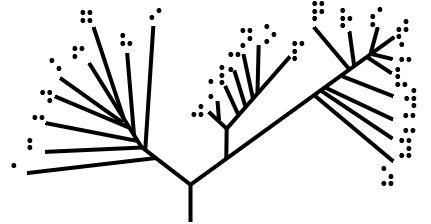|
Basal (phylogenetics)
In phylogenetics, basal is the direction of the ''base'' (or root) of a phylogenetic tree#Rooted tree, rooted phylogenetic tree or cladogram. The term may be more strictly applied only to nodes adjacent to the root, or more loosely applied to nodes regarded as being close to the root. Note that extant taxa that lie on branches connecting directly to the root are not more closely related to the root than any other extant taxa. While there must always be two or more equally "basal" clades sprouting from the root of every cladogram, those clades may differ widely in taxonomic rank, Phylogenetic diversity, species diversity, or both. If ''C'' is a basal clade within ''D'' that has the lowest rank of all basal clades within ''D'', ''C'' may be described as ''the'' basal taxon of that rank within ''D''. The concept of a 'key innovation' implies some degree of correlation between evolutionary innovation and cladogenesis, diversification. However, such a correlation does not make a given ca ... [...More Info...] [...Related Items...] OR: [Wikipedia] [Google] [Baidu] |
Phylogenetics
In biology, phylogenetics () is the study of the evolutionary history of life using observable characteristics of organisms (or genes), which is known as phylogenetic inference. It infers the relationship among organisms based on empirical data and observed heritable traits of DNA sequences, protein amino acid sequences, and morphology. The results are a phylogenetic tree—a diagram depicting the hypothetical relationships among the organisms, reflecting their inferred evolutionary history. The tips of a phylogenetic tree represent the observed entities, which can be living taxa or fossils. A phylogenetic diagram can be rooted or unrooted. A rooted tree diagram indicates the hypothetical common ancestor of the taxa represented on the tree. An unrooted tree diagram (a network) makes no assumption about directionality of character state transformation, and does not show the origin or "root" of the taxa in question. In addition to their use for inferring phylogenetic pa ... [...More Info...] [...Related Items...] OR: [Wikipedia] [Google] [Baidu] |
Cladogenesis
Cladogenesis is an evolutionary splitting of a parent species into two distinct species, forming a clade. This event usually occurs when a few organisms end up in new, often distant areas or when environmental changes cause several extinctions, opening up ecological niches for the survivors and causing population bottlenecks and founder effects changing allele frequencies of diverging populations compared to their ancestral population. The events that cause these species to originally separate from each other over distant areas may still allow both of the species to have equal chances of surviving, reproducing, and even evolving to better suit their environments while still being two distinct species due to subsequent natural selection, mutations and genetic drift. Cladogenesis is in contrast to anagenesis, in which an ancestral species gradually accumulates change, and eventually, when enough is accumulated, the species is sufficiently distinct and different enough from its ... [...More Info...] [...Related Items...] OR: [Wikipedia] [Google] [Baidu] |
Plesiomorphic
In phylogenetics, a plesiomorphy ("near form") and symplesiomorphy are synonyms for an ancestral character shared by all members of a clade, which does not distinguish the clade from other clades. Plesiomorphy, symplesiomorphy, apomorphy, and synapomorphy all mean a trait shared between species because they share an ancestral species. Apomorphic and synapomorphic characteristics convey much information about evolutionary clades and can be used to define taxa. However, plesiomorphic and symplesiomorphic characteristics cannot. The term ''symplesiomorphy'' was introduced in 1950 by German entomologist Willi Hennig. Examples A backbone is a plesiomorphic trait shared by birds and mammals, and does not help in placing an animal in one or the other of these two clades. Birds and mammals share this trait because both clades are descended from the same far distant ancestor. Other clades, e.g. snakes, lizards, turtles, fish, frogs, all have backbones and none are either birds n ... [...More Info...] [...Related Items...] OR: [Wikipedia] [Google] [Baidu] |
Phenotypic Trait
A phenotypic trait, simply trait, or character state is a distinct variant of a phenotypic characteristic of an organism; it may be either inherited or determined environmentally, but typically occurs as a combination of the two.Lawrence, Eleanor (2005) ''Henderson's Dictionary of Biology''. Pearson, Prentice Hall. For example, having eye color is a ''character'' of an organism, while blue, brown and hazel versions of eye color are ''traits''. The term ''trait'' is generally used in genetics, often to describe the phenotypic expression of different combinations of alleles in different individual organisms within a single population, such as the famous purple vs. white flower coloration in Gregor Mendel's pea plants. By contrast, in systematics, the term ''character state'' is employed to describe features that represent fixed diagnostic differences among taxa, such as the absence of tails in great apes, relative to other primate groups. Definition A phenotypic trait is ... [...More Info...] [...Related Items...] OR: [Wikipedia] [Google] [Baidu] |
Allele
An allele is a variant of the sequence of nucleotides at a particular location, or Locus (genetics), locus, on a DNA molecule. Alleles can differ at a single position through Single-nucleotide polymorphism, single nucleotide polymorphisms (SNP), but they can also have insertions and deletions of up to several thousand base pairs. Most alleles observed result in little or no change in the function or amount of the gene product(s) they code or regulate for. However, sometimes different alleles can result in different observable phenotypic traits, such as different pigmentation. A notable example of this is Gregor Mendel's discovery that the white and purple flower colors in pea plants were the result of a single gene with two alleles. Nearly all multicellular organisms have two sets of chromosomes at some point in their biological life cycle; that is, they are diploid. For a given locus, if the two chromosomes contain the same allele, they, and the organism, are homozygous with re ... [...More Info...] [...Related Items...] OR: [Wikipedia] [Google] [Baidu] |
Lineage (genetic)
A genetic lineage includes all descendants of a given genetic sequence, typically following a new mutation. It is not the same as an allele because it excludes cases where different mutations give rise to the same allele, and includes descendants that differ from the ancestor by one or more mutations. The genetic sequence can be of different sizes, e.g. a single gene or a haplotype containing multiple adjacent genes along a chromosome. Given recombination, each gene can have a separate genetic lineages, even as the population shares a single organismal lineage. In asexual microbes or somatic cells, cell lineages exactly match genetic lineages, and can be traced. Incomplete lineage sorting Incomplete lineage sorting describes when the phylogenetic tree for a gene does not match that of the species. For example, while most human gene lineages coalesce first with chimpanzee lineages, and then with gorilla lineages, other configurations also occur. Lineage selection Lineage s ... [...More Info...] [...Related Items...] OR: [Wikipedia] [Google] [Baidu] |
LUCA
Luca or LUCA may refer to: People * Luca (masculine given name), including a list of people * Luca (feminine given name), including a list of people * Luca (surname), including a list of people Places * The ancient name of Lucca, an Etruscan city of Roman Italy Fictional characters * Luca Tsukino, in the 2019 film '' Doraemon: Nobita's Chronicle of the Moon Exploration'' * Luca Paguro, in the 2021 film '' Luca'' * Luca (Yu-Gi-Oh! 5D's), in the anime series * Luca (''Final Fantasy'' character) Arts and entertainment * Luca (''Final Fantasy'' setting), of the video games * Luca Family Singers, US * ''Luca'' (2019 film), in Indian Malayalam-language * ''Luca'' (2021 film), Disney/Pixar animation * A song by Brand New from the album ''The Devil and God Are Raging Inside Me'' * Luca, a scrub jay from Angry Birds Stella and the animation Biology * ''Luca'' (genus), moths in the family Notodontidae * Last universal common ancestor, of all organisms on Earth Other uses * L ... [...More Info...] [...Related Items...] OR: [Wikipedia] [Google] [Baidu] |
Lineage (evolution)
An evolutionary lineage is a temporal series of populations, organisms, cells, or genes connected by a continuous line of descent from ancestor to descendant. Lineages are subsets of the evolutionary tree of life. Lineages are often determined by the techniques of molecular systematics. Phylogenetic representation of lineages upright=1.4, A rooted tree of life into three ancient monophyletic lineages: archaea.html" ;"title="bacteria, archaea">bacteria, archaea, and eukaryotes based on rRNA genes Lineages are typically visualized as subsets of a phylogenetic tree. A lineage is a single line of descent or linear chain within the tree, while a clade is a (usually branched) monophyletic group, containing a single ancestor and all its descendants. Phylogenetic trees are typically created from DNA, RNA or protein sequence data. Apart from this, morphological differences and similarities have been, and still are used to create phylogenetic trees. Sequences from different individua ... [...More Info...] [...Related Items...] OR: [Wikipedia] [Google] [Baidu] |
Phylogenetic Tree
A phylogenetic tree or phylogeny is a graphical representation which shows the evolutionary history between a set of species or taxa during a specific time.Felsenstein J. (2004). ''Inferring Phylogenies'' Sinauer Associates: Sunderland, MA. In other words, it is a branching diagram or a tree showing the evolutionary relationships among various biological species or other entities based upon similarities and differences in their physical or genetic characteristics. In evolutionary biology, all life on Earth is theoretically part of a single phylogenetic tree, indicating common ancestry. Phylogenetics is the study of phylogenetic trees. The main challenge is to find a phylogenetic tree representing optimal evolutionary ancestry between a set of species or taxa. Computational phylogenetics (also phylogeny inference) focuses on the algorithms involved in finding optimal phylogenetic tree in the phylogenetic landscape. Phylogenetic trees may be rooted or unrooted. In a ''rooted'' p ... [...More Info...] [...Related Items...] OR: [Wikipedia] [Google] [Baidu] |
Core Eudicots
The eudicots or eudicotyledons are flowering plants that have two seed leaves (cotyledons) upon germination. The term derives from ''dicotyledon'' (etymologically, ''eu'' = true; ''di'' = two; ''cotyledon'' = seed leaf). Historically, authors have used the terms tricolpates or non-magnoliid dicots. The current botanical terms were introduced in 1991, by evolutionary botanist James A. Doyle and paleobotanist Carol L. Hotton, to emphasize the later evolutionary divergence of tricolpate dicots from earlier, less specialized, dicots. Scores of familiar plants are eudicots, including many commonly cultivated and edible plants, numerous trees, tropicals and ornamentals. Among the most well-known eudicot genera are those of the sunflower (''Helianthus''), dandelion (''Taraxacum''), forget-me-not ('' Myosotis''), cabbage ('' Brassica''), apple (''Malus''), buttercup ('' Ranunculus''), maple ('' Acer'') and macadamia (''Macadamia''). Most leafy, mid-latitude trees are also classifi ... [...More Info...] [...Related Items...] OR: [Wikipedia] [Google] [Baidu] |
Sister Group
In phylogenetics, a sister group or sister taxon, also called an adelphotaxon, comprises the closest relative(s) of another given unit in an evolutionary tree. Definition The expression is most easily illustrated by a cladogram: Taxon A and taxon B are sister groups to each other. Taxa A and B, together with any other extant or extinct descendants of their most recent common ancestor (MRCA), form a monophyletic group, the clade AB. Clade AB and taxon C are also sister groups. Taxa A, B, and C, together with all other descendants of their MRCA form the clade ABC. The whole clade ABC is itself a subtree of a larger tree which offers yet more sister group relationships, both among the leaves and among larger, more deeply rooted clades. The tree structure shown connects through its root to the rest of the universal tree of life. In cladistic standards, taxa A, B, and C may represent specimens, species, genera, or any other taxonomic units. If A and B are at the same taxono ... [...More Info...] [...Related Items...] OR: [Wikipedia] [Google] [Baidu] |
Ursidae
Bears are carnivoran mammals of the family (biology), family Ursidae (). They are classified as caniforms, or doglike carnivorans. Although only eight species of bears are extant, they are widespread, appearing in a wide variety of habitats throughout most of the Northern Hemisphere and partially in the Southern Hemisphere. Bears are found on the continents of North America, South America, and Eurasia. Common characteristics of modern bears include large bodies with stocky legs, long snouts, small rounded ears, shaggy hair, plantigrade paws with five nonretractile claws, and short tails. While the polar bear is mostly carnivorous, and the giant panda is mostly herbivorous, the remaining six species are omnivorous with varying diets. With the exception of courtship display, courting individuals and mothers with their young, bears are typically solitary animals. They may be diurnality, diurnal or nocturnal and have an excellent sense of smell. Despite their heavy build and awk ... [...More Info...] [...Related Items...] OR: [Wikipedia] [Google] [Baidu] |





